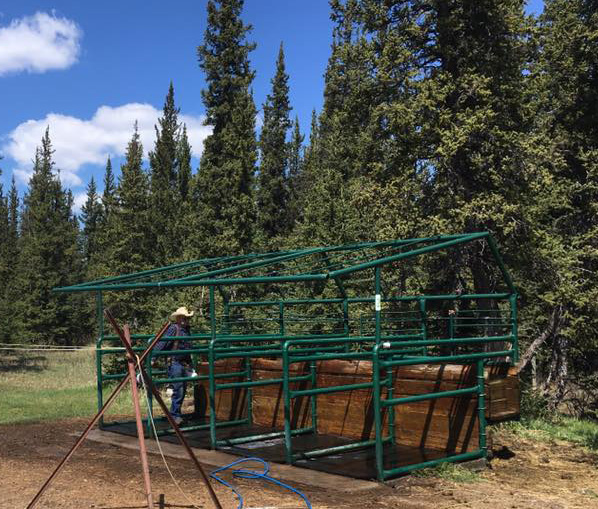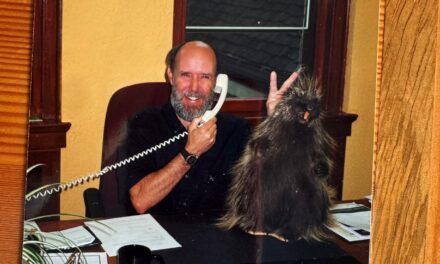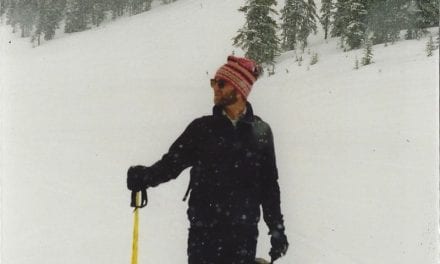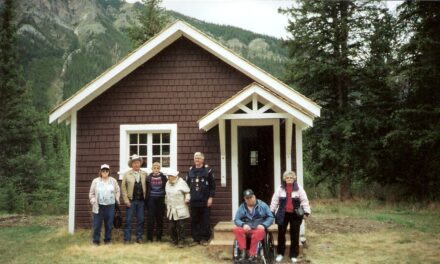Rod: So you have a good working relationship with the province.
Dale: Yes.
Rod: Do you have a formal MOU with the province for other campgrounds?
Dale: Yes.
Larry: We have six campgrounds in total now. We are a recognized umbrella group for those areas. If there is anything to be done in those areas, other user groups are to go through us.
Clarence: At our meeting on July 14, 1994 with Percy Weibe, Ken Pigeon and also Alberta Forestry officers we talked about long term tenure at the Bighorn Campground, and we requested a possible 25 year lease at that time. Then they went to a possible MOU with the Province of Alberta; and then they kind of dropped that; and then time went on. This is when we thought it (the MOU with the Province, Parks Canada and FOESA) was all signed. Finally we got the one through Perry Jacobson (between Parks Canada and FOESA only).
Rod: I am quite curious about that because I wonder how many volunteer hours you expend. Do you keep track of your volunteer hours?
Larry: We try to have that assessment done annually before we do our audit to throw that into the mix. That is, what there is for volunteer hours from the directorship. There is also the donated man hours, equipment and materials donated from other members and from industry.
Dale: Volunteer hours, equipment and materials add up to hundreds of thousands of dollars in value.
Larry: Volunteer hours and equipment (donation) add up.
Rod: Does industry help you at all?
Dale: A lot.
Rod: And the province, do they?
Larry: Very minimal; almost negligible.
Marie: Does the ranch still contribute the use of the tractor for campground clean-up and manure piling?
Larry: Yes. The people at the ranch they have been great to work with. They are in there working with us whenever we have a need. For instance if the manure gets spread out too much Rick will send one of the guys down with the tractor to push it back up, so we don’t have to run a skid steer out from Sundre or somewhere to do that.
Rod: Does industry send out an operator for equipment they donate?
Larry: In most cases yes!
Dale: We’ve had big help from Shell Canada. They sent a grader and an operator and paid for the trucks to haul them back and forth.
Larry: Shell has been phenomenal.
Clarence: When we originally started I sat on the Panther Advisory Group run by Suncor and Shell and we would have a work bee. I’d phone Suncor and we’d get three trucks to haul gravel. We got a lot of gravel from the Bull Hill pit and we paid the county the price of the crushing only.
Rod: So the county helped out a little bit.
Dale: The country (of Clearwater) is still helping out. The last little while Clearwater County has not even charged for the crushing. And last year Shell gave us a lot of gravel but it sort of cost us in the long run because even though we had a good deal on the trucking, the actual trucking cost us a lot of money. We distributed the gravel between the Hummingbird, Cutoff and 7-Mile Campgrounds.
Rod: Did your membership fees cover the cost of the gravel?
Larry: Yes. Also our fundraisers and grants helped.
Rod: Has there been any opportunity to get any grants through the province?
Larry: Clarence started the ball rolling with the Panther Advisory Group.
Clarence: I recall some grants – I think the road that we put through the campground was paid for with a (provincial) grant from Sports, Recreation and Wildlife. I think there was an office in Olds at the time. I can’t recall. It would have been reported in one of our newsletters – the one I can’t find. I think it cost about $22,000 to put that road through the campground. The grant was in the amount of $22,000 and we received it in about 1995. And then we got another grant for $7,500 to put the tie stalls in.
Marie: Yes, we were there when you put the PMU (Pregnant Mare Urine) stalls in. It was fantastic – I can’t recall how many stalls you put in, but I recall they were in sets of 4 or 5 stalls.

Former PMU stalls at the Bighorn Campg
round.
Clarence: I think we put in 60 stalls.
Marie: The stalls were placed strategically throughout the campground and painted to green to blend in with the foliage. They are still being used.
Rod: You have done a terrific job.
Marie: I see you have framework welded on now for users to place tarps overhead.
Larry: Everybody cut trees down on their way to the Ya Ha Tinda and tried to make their own framework for tarps so we made metal framework that is much safer.
Clarence: There was a meeting on March of 1999 where Perry Jacobson was there. And we discussed stalls at that time. He gave us the authority to go ahead and do that.
Another important thing that Perry recommended we do was the brochure. I remember that I believe we paid $2300 to develop the brochure and trail map.
Rod: It’s very obvious how important it was that Perry Jacobson was there at the time to be able to facilitate a lot of this stuff for the Friends of the Eastern Slopes. Who knows what other kind of manager would have been able to do that.
Clarence: Yes. I remember one time he came out to the ranch, and John Nylund had the quad and trailer down there at the campground. And it was wintertime and it was cold and him and I were sitting in the back of that trailer and John was driving and we were looking at what we should be doing in the campground.
Rod: I was talking to Perry last week and he was saying that was a period in Parks Canada where the local manager could make those kinds of decisions. (As an example) Now, you’ve got to consult with Ottawa if you have a problem bear; you have to ask some desk jockey in Ottawa what you should do with this bear.
Clarence: (referring to his files) I just found a reference to where we received a grant for $7500 from Alberta Sports Recreation and Wildlife. That was in 1999 and that was basically how we covered the cost of the stalls. The first grant we got prior to this one, I think it was for $22,000 for the road. And then we went on to get some other grants – this was a fund set up by Shell – and we got a number of grants from that. We also got a provincial grant through the MLAs office. We received $13,500 and that was for the Hummingbird campground, I believe.
Rod: Well, that is terrific.
Dale: We got a grant from Shell-Suncor for the sign that is up at Eagle Lake. I can’t recall the time period for that.
Clarence: That was probably around 2005 or 2007. We started the Big Horn Backcountry committee in 2001. And it was sometime after that.
Rod: So you really have had major support on the campground. Was parks commitment only casual labour and working with you on the issues that might develop.
Clarence: We were just happy to be there and were very happy to work with Parks Canada.
Rod: Well, full credit to you for stepping up to the plate and working with Parks. If you didn’t have a group of dedicated people things could have gone 180 degrees.
Marie: The Friends of the Eastern Slopes have also developed a comprehensive set of user rules pertaining to the campground.
Clarence: Here’s a good one referring to a letter from Parks Canada – he refers to our persistent reminders.
Larry: We can thank Clarence for that.
Clarence: As long as they were pleased with what we were doing that is how we always looked at it.
Rod: It sounds like a really good working relationship. A few awkward moments but you worked through it.
Larry: The relationship with Parks Canada has been pretty smooth all along.
Clarence: I think the one important thing is that we are only one organization working with parks. For instance, with the Bighorn Backcountry Plan Committee there was all kinds of organizations involved and everybody wanted their little piece of the pie a little different way. But, with FOESA and Parks Canada we were a single entity and it made it real easy (for both parties).
Rod: I know there are some grants that the federal government issues in terms of environmental programs, like reclamation projects – have you ever tried to apply for any of those?
Clarence: In 2008-09 there were grants that came out but no we did not apply for any. I think the Olds Snowmobile Club got $25,000 to do their trails. I think the ATV trails that were done on Rig Street Road may have been done with that grant money.
Dale: The grant money did not come directly to us but to the people (groups) that were involved in the ATV trails.
Clarence: I think it was 2008-2009 that the Harper government came out with these grants to create employment.
Rod: Western Economic Development had a lot of funds available for many projects and I wondered if you had applied.
Rod: I want to summarize some of the other activities the Friends of the Eastern Slopes have been involved in beyond the Ya Ha Tinda. You mentioned the restoration of Black Rock Lookout Tower project and other ones that you’ve been involved. I understand that you do regular maintenance on a number of campgrounds in the province.
Clarence: In 2001 the Bighorn Backcountry was set up. By 2002 a committee was established, rules were developed and it was legislated. After that, FOESA was able to improve Eagle Creek, Cutoff Creek, The Hummingbird and all those areas. We did a tremendous amount of work in those campgrounds. In the Hummingbird we took out trees in three different areas and built campgrounds. We put in roads and outhouses.
Rod: Again, do you keep track of the number of hours and expenses?
Clarence: I was involved in it but I just kept track of how the work was done and how much money was spent. And I got the records for the period 2004 to 2010 but not since 2010.
Dale: Yeah, we’ve tried to keep track of both.
Rod: Yes, I think that is very astute.
Larry: The last few years we’ve tried to keep track of the hours.
Rod: It is important to reflect that you have spent that much time on these projects. And your membership has grown?
Larry: FOESA’s latest endeavor – and Dale was one to get on top of this with Clarence – was working with the province to get some of these locked campgrounds opened up. An example is Seven Mile Flats. It sat locked for over 5 years. (FOESA has taken in over) It is our second year now. We had a work bee there. Those campgrounds were not built for these 40-foot trailers that people haul. So we went in there and we took on the task of clearing trees and taking branches off to try to make it navigable.
Rod: Well, that is no small project.
Rod: What about the 2013 flood? There must have been a considerable amount of work done to rectify some of the problems at the Bighorn Campground with flooding that went right through the campground.
Dale: We had a cat and a Shell grader and operator. The ranch used their tractor and Tim Barton was there with his tractor. We picked up the logs that had washed up and leveled out and filled in areas. We rebuilt some roads.
Clarence: There were other floods too – 2005, 2007 and 2009 the water from the river went through there too. So we just rebuilt it.
Larry: It washed again about three weeks ago.
Clarence: It is a continual thing.
Dale: And we’ve made some mistakes in designing the berm but since we’ve learned how to pound those pilings into the ground, you surround it with fill and you can redirect the water. Or make it so it can’t come out so much. And one day they were going to give us the go-ahead (to maintain the berm) but now we haven’t had an answer (to our emails). Part of our Memorandum of Understanding is to maintain the berm but they won’t give us the go-ahead to…




Recent Comments